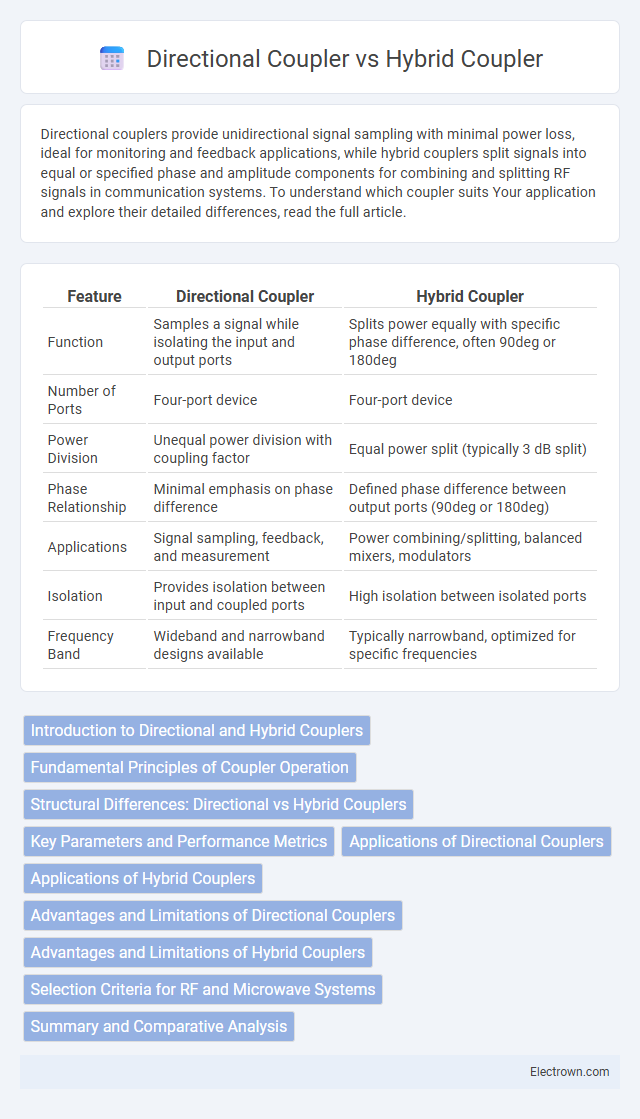Directional couplers provide unidirectional signal sampling with minimal power loss, ideal for monitoring and feedback applications, while hybrid couplers split signals into equal or specified phase and amplitude components for combining and splitting RF signals in communication systems. To understand which coupler suits Your application and explore their detailed differences, read the full article.
Table of Comparison
| Feature | Directional Coupler | Hybrid Coupler |
|---|---|---|
| Function | Samples a signal while isolating the input and output ports | Splits power equally with specific phase difference, often 90deg or 180deg |
| Number of Ports | Four-port device | Four-port device |
| Power Division | Unequal power division with coupling factor | Equal power split (typically 3 dB split) |
| Phase Relationship | Minimal emphasis on phase difference | Defined phase difference between output ports (90deg or 180deg) |
| Applications | Signal sampling, feedback, and measurement | Power combining/splitting, balanced mixers, modulators |
| Isolation | Provides isolation between input and coupled ports | High isolation between isolated ports |
| Frequency Band | Wideband and narrowband designs available | Typically narrowband, optimized for specific frequencies |
Introduction to Directional and Hybrid Couplers
Directional couplers and hybrid couplers are essential components in RF and microwave systems, designed to split or combine signals with specific power division ratios and phase relationships. Directional couplers primarily provide coupling with high directivity and minimal signal reflection, facilitating power measurement and signal sampling. Hybrid couplers achieve equal power division with precise phase shifts, enabling applications like balanced mixers and antenna feeds in complex communication systems.
Fundamental Principles of Coupler Operation
Directional couplers operate based on the principle of coupling a specific portion of the input signal to an output port while isolating the input from the coupled port, enabling signal monitoring without interruption. Hybrid couplers use a combination of transmission lines or waveguides designed to split power equally into two outputs with a fixed phase difference, typically 90deg or 180deg, facilitating balanced signal distribution or mixing. Understanding these fundamental principles helps you choose the right coupler type for applications requiring precise signal routing and power division.
Structural Differences: Directional vs Hybrid Couplers
Directional couplers feature two pairs of coupled transmission lines allowing signal sampling with minimal interference, while hybrid couplers use a four-port configuration designed for signal splitting and combining with specific phase relationships. The structural design of directional couplers emphasizes unidirectional signal flow through closely spaced lines, whereas hybrid couplers incorporate symmetrical geometries tailored to achieve 90-degree or 180-degree phase shifts. Understanding these structural differences helps optimize your circuit design for signal routing, power division, or isolation in RF and microwave applications.
Key Parameters and Performance Metrics
Directional couplers are characterized by parameters such as coupling factor, directivity, insertion loss, and isolation, which determine their ability to separate power flows in a transmission line with minimal signal leakage. Hybrid couplers, often 3 dB couplers, prioritize amplitude balance, phase balance, and return loss to achieve signal splitting or combining with equal power division and precise phase relationships. Both devices require careful consideration of bandwidth and frequency response to optimize performance in RF and microwave applications.
Applications of Directional Couplers
Directional couplers are widely used in RF and microwave systems for signal sampling, power measurement, and feedback in amplifiers, ensuring minimal signal disruption. They play a critical role in antenna feed networks, signal monitoring, and isolation in communication systems. Their precise coupling and directivity make them essential in test equipment and multiplexing applications.
Applications of Hybrid Couplers
Hybrid couplers are extensively used in RF and microwave systems for power splitting, combining signals, and phase shifting, enabling balanced mixer and balanced amplifier designs. They are critical components in beamforming networks for phased array antennas and are employed in radar and communication systems to isolate signals and improve system performance. Their ability to provide precise phase and amplitude control makes them indispensable in signal processing and measurement equipment.
Advantages and Limitations of Directional Couplers
Directional couplers offer precise signal sampling with minimal insertion loss, making them advantageous for monitoring power levels in RF systems. They provide excellent isolation between ports but have limited bandwidth and coupling flatness compared to hybrid couplers. Your choice depends on whether you prioritize compact design and straightforward measurement over the broader frequency range provided by hybrid couplers.
Advantages and Limitations of Hybrid Couplers
Hybrid couplers provide excellent isolation and equal power split with a consistent 90-degree phase difference, making them ideal for balanced mixers and phased array antennas. Their primary limitation is bandwidth restriction, as their performance degrades outside the designed frequency range, and they are generally more complex and bulkier than directional couplers. The ability of hybrid couplers to minimize signal reflection and improve port matching enhances system efficiency in RF and microwave applications.
Selection Criteria for RF and Microwave Systems
Selecting between a directional coupler and a hybrid coupler in RF and microwave systems depends primarily on power division requirements and signal isolation levels. Directional couplers are preferred for applications needing precise signal sampling with minimal insertion loss and high directivity, such as signal monitoring and feedback loops. Hybrid couplers are optimal for achieving equal power splitting with phase shift, crucial in balanced mixers, antenna arrays, and quadrature modulator designs.
Summary and Comparative Analysis
Directional couplers and hybrid couplers serve distinct functions in RF and microwave systems, with directional couplers primarily used for signal sampling and monitoring, while hybrid couplers enable power division and phase shifting with specific amplitude and phase characteristics. Directional couplers offer unidirectional coupling with isolation between ports, making them ideal for reflection measurements, whereas hybrid couplers provide equal power split with 90deg or 180deg phase differences critical in balanced mixers and phased array antennas. Your choice depends on whether you need accurate signal sampling or precise power splitting with phase control in applications such as communication systems or radar.
Directional Coupler vs Hybrid Coupler Infographic

 electrown.com
electrown.com